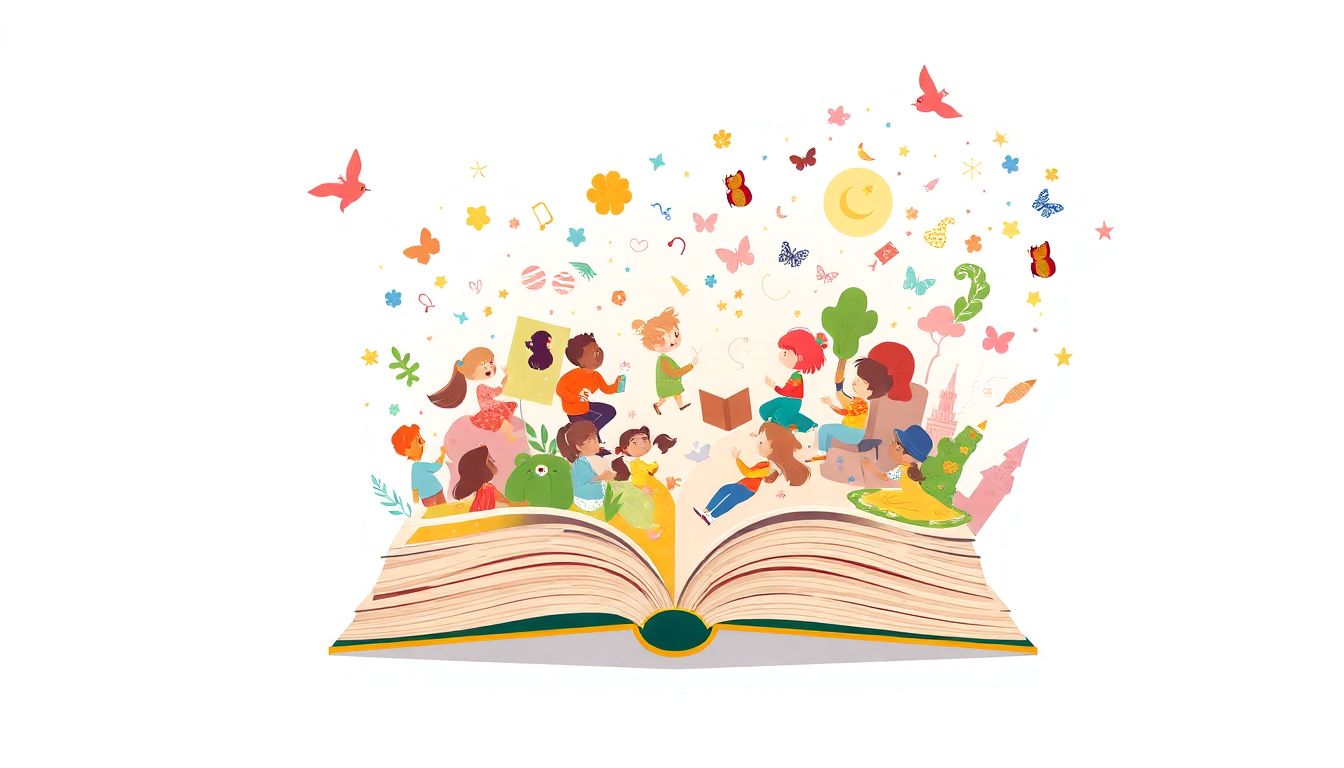You’re probably feeling a bit overwhelmed by how quickly children’s books are changing, right? The market shifts constantly, and knowing what’s hot or what’s about to be can leave you scratching your head.
No worries! Stick around and we’ll make things clearer. You’ll learn useful stuff like the formats kids actually enjoy, the rising popularity of inclusivity, and clever ways to market books online and globally.
Ready to tackle the children’s literature market head-on? Let’s get started!
Key Takeaways
- The children’s literature market continues steady growth, with hot categories including biographies, licensed character books, educational workbooks, holiday-themed fiction, and action-adventure stories.
- Diverse and inclusive books representing multicultural, disabled, and LGBTQ+ characters have strong demand with broad appeal in homes, schools, and libraries.
- Graphic novels and illustrated stories are booming, attracting both reluctant and enthusiastic young readers.
- Interactive eBooks, audiobooks, and personalized digital storytelling are rising in popularity, driven by higher use of screens and subscription platforms.
- Effective social media marketing, influencer collaborations, and seasonal content help authors successfully connect with parents, educators, and caregivers.
- Thinking globally, incorporating universal themes like eco-consciousness and emotional intelligence helps books resonate internationally.
- Future opportunities include personalized books, interactive storytelling, subscription-based models, and increased interest in mental health and environmental themes.

Step 1: Understand the Children’s Literature Market Right Now
The children’s literature market is currently valued at around $12.19 billion and will likely grow to $12.49 billion in 2025—slow but continuous growth. This means there’s still plenty of room for new authors and fresh ideas, especially if you choose trending categories and know what kids (and their parents) want to read.
Biographies aimed at younger readers are super popular right now, like those inspired by celebrities such as Taylor Swift, whose biography has sold close to a million copies. Licensed activity books featuring characters from Disney and Bluey are flying off shelves because kids always love familiar faces from their favorite TV shows or movies. Educational workbooks, like the Brain Quest series, have also made notable sales jumps.
Another hot trend is holiday-themed fiction; sales have surged by 12% recently. Action-adventure books, like “The Last Kids on Earth,” remain favorites for kids seeking a thrilling read. A good way to tap into these trends is to check out submission guidelines from up-to-date resources like the Book Markets Guide for Children’s Writers 2024, which lists current editorial contacts and agents looking for fresh talent.
Step 2: Focus on Diverse and Inclusive Children’s Books
In the last few years, there’s been a genuine push for more diverse kids’ books—and that’s not going away. Parents and educators want books that represent all kinds of families, cultures, and abilities. Publishers are actively searching for stories that feature characters from various backgrounds, such as different ethnicities, disabilities, LGBTQ+ families, and multicultural communities—just look at the excitement around books like “Eyes That Kiss in the Corners” by Joanna Ho or “Hair Love” by Matthew A. Cherry.
If you’re writing diverse stories, the key is to be authentic and respectful. Do your homework: consult experts in the cultures you write about, use sensitivity readers, and talk to real people whose experiences mirror your characters’. This effort resonates deeply with readers and can help broaden your audience and boost sales, too.
Additionally, market trends now highlight increased interest in children’s books covering important topics like mental health, eco-conscious living, and inclusivity. With an expanding global audience, inclusive and socially aware titles not only perform well in sales but also often become favorites in classrooms and libraries.
Step 3: Include Popular Formats Like Graphic Novels and Illustrated Books
Graphic novels and illustrated children’s books aren’t just a passing fad—they’re currently one of the fastest-growing categories in the market. With visual storytelling capturing readers’ interest, many publishers are actively seeking fresh graphic novels targeting elementary and middle-grade readers. Popular graphic novel series like Raina Telgemeier’s “Smile” or Dav Pilkey’s “Dog Man” books have shown enormous success, proving these formats can attract reluctant readers and avid fans alike.
To break into this category, consider transforming a compelling story into a visually driven format or collaborating with illustrators. Keep in mind, graphic novels and illustrated books work especially well for action-adventure, humor, or even emotionally rich personal stories. If you’re interested in this format, here’s a helpful resource on how you can publish a graphic novel successfully.
Using clear panel layouts, engaging artwork, and concise dialogue, graphic novels and illustrated children’s books help kids who are visual learners engage deeply with stories. These books let kids interpret facial expressions, action scenes, and settings visually, enhancing their reading experience and boosting your book’s appeal.

Step 4: Consider Digital Books and Interactive Content for Kids
If you’re writing children’s books, don’t overlook digital opportunities like eBooks and audiobooks, which are showing nice growth these days.
The market for kids’ books is split across print books, eBooks, and audiobooks, and right now, digital formats are on the rise, especially because tablets and smartphone usage among younger kids keeps increasing.
Interactive eBooks—those that include animations, games, and clickable elements—are a big hit because they engage kids far beyond just reading words on a page.
Integrating elements like popular video games or personalized storytelling is really growing in popularity. Series like the “Minecraft” adventure stories that tie directly into the game itself are huge bestsellers, proving that digital integration works great.
You can create your own interactive experiences without breaking the bank: platforms like Book Creator or Kotobee let authors turn their books into interactive apps, often for reasonable prices or even for free.
Speaking of digital, have you thought about audiobooks? Companies like Audible have whole collections targeted specifically toward young listeners, offering another way to reach families who prefer listening.
Also, subscription models where parents pay monthly for unlimited access to digital libraries—like Epic!—are becoming more popular, making these platforms excellent venues for debut authors to share their work.
Step 5: Use Social Media Marketing to Reach More Readers
If you’re writing books for kids, you’re actually selling to their parents, grandparents, and teachers, so using social media effectively is crucial to boost your reach and sales.
Instagram, Facebook, and Pinterest continue to be the most effective platforms for children’s book authors, especially if your book features eye-catching illustrations or colorful graphics.
But don’t just post pretty cover images: parents and teachers cherish valuable and actionable content. Share helpful resources such as activity sheets, related educational tips, or fun writing prompts geared toward young readers.
One smart strategy is planning seasonal marketing campaigns tied to holidays or special occasions, offering things like free printable holiday coloring pages to promote your book. For instance, you can use engaging winter-themed writing prompts to attract young readers and their families.
Consider partnering up with influencers or parent-bloggers who have followers in your book’s age group; a single recommendation from a trusted blogger can significantly increase your visibility.
Another useful trick is joining kid-lit communities and groups on Facebook—engaging genuinely there allows you to promote your work naturally, connect directly with parents, teachers, and librarians, and get useful feedback.
Step 6: Pay Attention to the Global Children’s Literature Market Trends
Thinking beyond your local market matters, especially as children’s literature becomes more globalized and demand for diverse, culturally inclusive stories rises worldwide.
Translations and foreign rights can open a lot of doors for your book. Titles like “The Gruffalo” by Julia Donaldson became global sensations precisely because they appeal to kids universally, across cultures.
Understanding international trends like eco-friendly living and social-emotional learning issues gives you an advantage. If you integrate universal themes such as kindness, empathy, environmental care, or mental health into your stories, they have a broader appeal internationally.
Countries with rising household disposable incomes—like the UK, which saw a 6.3% increase in disposable family incomes recently—are great regions for authors to consider expanding into or targeting.
Publishers often emphasize acquiring global distribution rights, and digital publishing platforms such as Amazon Kindle Direct Publishing (KDP) offer instant global reach, so these services are well worth considering.
If you learn how to sell eBooks on your own website, you can directly reach international customers without middlemen, increasing your profits and reader base at once.
Step 7: Identify Future Opportunities in Children’s Books for 2025 and Beyond
Wondering what’s going to happen in children’s publishing from 2025 onwards? It’s safe to say focusing on personalization and interactive storytelling are smart areas to explore.
Personalized books—where kids see their own names, characteristics, or images in the stories—are booming. Brands like Wonderbly already proved kids and parents love the personal touch, and this segment will likely grow further in the coming years.
Interactive adventures and choose-your-own-path digital stories also represent a growing trend. Kids like to exert some control over their stories, picking choices that shape the characters’ journeys, making reading feel more like a video-game experience.
A strong future growth area also includes incorporating topics around mental health, emotional intelligence, and life coping skills, topics that educators and parents highly value and seek out.
Another promising direction is eco-conscious storytelling, reflecting parents’ concerns over the environment and sustainability, resonating strongly due to the climate issues spotlighted globally.
Subscription services tailored specifically to kids, offering book boxes, interactive content, and digital media at a flat monthly fee, will expand even more, so exploring this model could be clever.
With independent bookstores becoming more popular again, approaching these stores directly can yield great results. They’re often eager to stock titles from local or new authors and help organize reading events or author meet-ups.
By keeping an eye on these upcoming trends and listening carefully to the desires of families and children, you’ll position yourself perfectly for success as a children’s book author in the near future.
FAQs
Current trends emphasize diversity, inclusivity, and representation. Formats like graphic novels and highly visual books are growing popular, along with digital and interactive experiences. Social media also significantly influences book discovery and popularity among parents and educators.
Diversity and inclusivity help children appreciate different cultures and identities early in life. Seeing diverse characters positively impacts self-esteem and empathy, supporting broader understanding and acceptance of varied perspectives and experiences from childhood onward.
Graphic novels and illustrated books engage children visually and help build literacy skills, encourage reluctant readers, and inspire creativity and imagination. The visual storytelling style makes complex themes accessible and enjoyable, especially for younger readers.
Authors can build strong followings by regularly sharing engaging content, behind-the-scenes updates, book previews, and interactive elements targeting parents, librarians, and teachers. Platforms like Instagram and TikTok are ideal for visually appealing storytelling and community building.